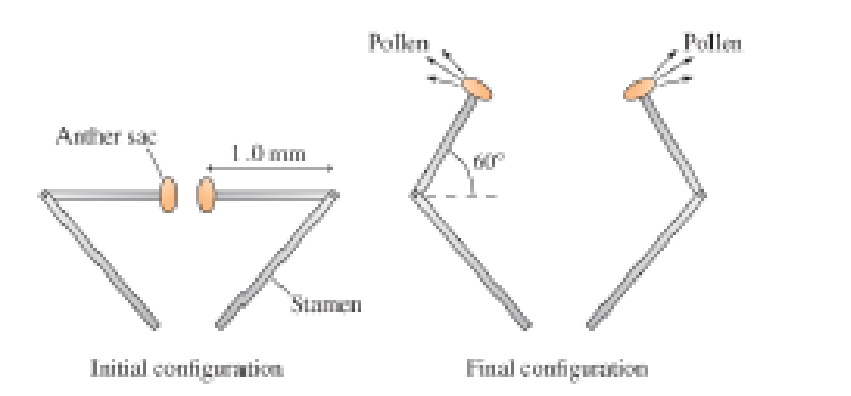
Concept explainers
The Bunchberry

The bunchberry flower has the fastest-moving parts ever seen in a plant. Initially, the stamens are held by the petals in a bent position, storing energy like a coiled spring. As the petals release, the tips of the stamens fly up and quickly release a burst of pollen.
Figure P7. 72 shows the details of the motion. The tips of the stamens act like a catapult, flipping through a 60° angle; the times on the earlier photos show that this happens in just 0.30 ms. We can model a stamen tip as a 1.0-mm-Jong, 10 μg rigid rod with a 10 μg anther sac at one end and a pivot point at the opposite end. Though an oversimplification, we will model the motion by assuming the

Figure P7.72
72. What is the angular acceleration of the anther sac during the motion?
A. 3.5 × 103 rad/s2
B. 7.0 × 103 rad/s2
C. 1.2 × 107 rad/s2
D. 2.3 × 107 rad/s2
Want to see the full answer?
Check out a sample textbook solution
Chapter 7 Solutions
COLLEGE PHYSICS:STRATEGIC APPR.AP ED.
Additional Science Textbook Solutions
Physics for Scientists and Engineers: A Strategic Approach, Vol. 1 (Chs 1-21) (4th Edition)
Chemistry: A Molecular Approach (4th Edition)
Campbell Biology: Concepts & Connections (9th Edition)
Chemistry: An Introduction to General, Organic, and Biological Chemistry (13th Edition)
Microbiology: An Introduction
Campbell Biology (11th Edition)
- Uniform Circular motion. 1. Mini Lecture 2. Let the position of a particle be given by: (t) = Rcos (wt)i + Rsin (wt)j 3. Calculate the expression for the velocity vector and show that the velocity vector is tangential to the circumference of the circle. 4. Calculate the expression for the acceleration vector and show that the acceleration vector points radially inward. 5. Calculate the magnitude of the velocity and magnitude of the acceleration, and therefore show that v2 a = Rarrow_forward4. A ball is thrown vertically up, its speed. slowing under the influence of gravity. Suppose (A) we film this motion and play the tape backward (so the tape begins with the ball at its highest point and ends with it reaching the point from which it was released), and (B) we observe the motion of the ball from a frame of reference moving up at the initial speed of the ball. The ball has a downward acceleration g in: a. A and B b. Only A c. Only B d. Neither A nor Barrow_forward2. Consider a 2.4 m long propeller that operated at a constant 350 rpm. Find the acceleration of a particle at the tip of the propeller.arrow_forward
- 2. A football is kicked at an angle 37.0° above the horizontal with a velocity of 20.0 m/s, as Calculate (a) the maximum height, (b) the time of travel before the football hits the ground, and (c) how far away it hits the ground. Assume the ball leaves the foot at ground level, and ignore air resistance, wind, and rotation of the ball.arrow_forwardPlease don't use Chatgpt will upvote and give handwritten solutionarrow_forwardCam mechanisms are used in many machines. For example, cams open and close the valves in your car engine to admit gasoline vapor to each cylinder and to allow the escape of exhaust. The principle is illustrated in the figure below, showing a follower rod (also called a pushrod) of mass m resting on a wedge of mass M. The sliding wedge duplicates the function of a rotating eccentric disk on a camshaft in your car. Assume that there is no friction between the wedge and the base, between the pushrod and the wedge, or between the rod and the guide through which it slides. When the wedge is pushed to the left by the force F, the rod moves upward and does something such as opening a valve. By varying the shape of the wedge, the motion of the follower rod could be made quite complex, but assume that the wedge makes a constant angle of 0 = 15.0°. Suppose you want the wedge and the rod to start from rest and move with constant acceleration, with the rod moving upward 1.00 mm in 8.00 ms. Take m…arrow_forward
 Physics for Scientists and Engineers: Foundations...PhysicsISBN:9781133939146Author:Katz, Debora M.Publisher:Cengage Learning
Physics for Scientists and Engineers: Foundations...PhysicsISBN:9781133939146Author:Katz, Debora M.Publisher:Cengage Learning Principles of Physics: A Calculus-Based TextPhysicsISBN:9781133104261Author:Raymond A. Serway, John W. JewettPublisher:Cengage Learning
Principles of Physics: A Calculus-Based TextPhysicsISBN:9781133104261Author:Raymond A. Serway, John W. JewettPublisher:Cengage Learning Physics for Scientists and EngineersPhysicsISBN:9781337553278Author:Raymond A. Serway, John W. JewettPublisher:Cengage Learning
Physics for Scientists and EngineersPhysicsISBN:9781337553278Author:Raymond A. Serway, John W. JewettPublisher:Cengage Learning Physics for Scientists and Engineers with Modern ...PhysicsISBN:9781337553292Author:Raymond A. Serway, John W. JewettPublisher:Cengage Learning
Physics for Scientists and Engineers with Modern ...PhysicsISBN:9781337553292Author:Raymond A. Serway, John W. JewettPublisher:Cengage Learning University Physics Volume 1PhysicsISBN:9781938168277Author:William Moebs, Samuel J. Ling, Jeff SannyPublisher:OpenStax - Rice University
University Physics Volume 1PhysicsISBN:9781938168277Author:William Moebs, Samuel J. Ling, Jeff SannyPublisher:OpenStax - Rice University Physics for Scientists and Engineers, Technology ...PhysicsISBN:9781305116399Author:Raymond A. Serway, John W. JewettPublisher:Cengage Learning
Physics for Scientists and Engineers, Technology ...PhysicsISBN:9781305116399Author:Raymond A. Serway, John W. JewettPublisher:Cengage Learning





